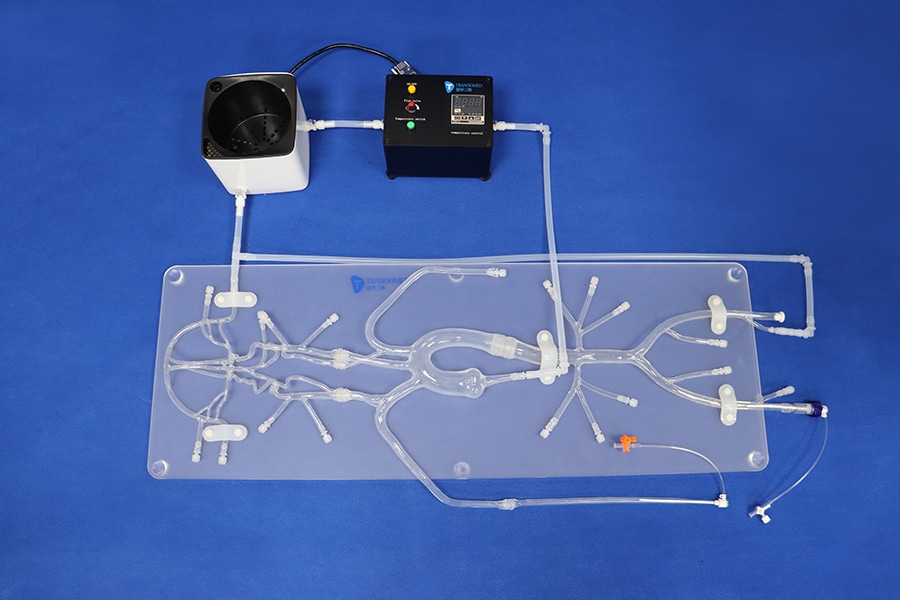
#Industry News
Advancements in Neurointerventional Vascular Models and Hemodynamic Equipment
Neuro Vascular System I (with aneurysm)
Introduction
The field of neurointerventional medicine has witnessed remarkable advancements over the years, particularly in the development of vascular models and hemodynamic equipment. These innovative technologies are revolutionizing the diagnosis, treatment, and research efforts in neurovascular diseases. In this article, we will explore the significance, benefits, and recent advancements in neurointerventional vascular models and hemodynamic equipment.
Neurointerventional Vascular Models
Neurointerventional vascular models are anatomically accurate replicas of the human cerebrovascular system. These models are constructed using various materials such as 3D-printed plastics, silicone, or gelatin. They simulate the complex geometry and physiological characteristics of blood vessels in the brain, allowing physicians and researchers to study and practice intricate procedures in a controlled environment.
Benefits of Neurointerventional Vascular Models
a) Training and Education: Vascular models provide a realistic platform for training neurointerventional specialists, allowing them to practice and refine their skills before performing procedures on actual patients. This leads to improved safety and outcomes.
b) Treatment Planning: Neurovascular models enable physicians to plan and simulate procedures, such as aneurysm coiling or embolization, providing a better understanding of the patient's unique anatomy. This helps optimize treatment strategies, resulting in enhanced patient care.
c) Device Testing and Innovation: Vascular models serve as valuable tools for testing new devices and techniques in a controlled laboratory setting. Manufacturers can assess device performance, evaluate safety parameters, and refine their designs before clinical implementation.
Recent Advancements in Neurointerventional Vascular Models
i) Patient-Specific Models: Utilizing advanced imaging techniques like computed tomography angiography (CTA) or magnetic resonance angiography (MRA), patient-specific neurointerventional vascular models can be created. These models accurately replicate a patient's unique vascular anatomy, facilitating individualized treatment planning.
ii) Hemodynamics Simulation: Incorporating software and computational fluid dynamics (CFD), vascular models can simulate blood flow and hemodynamic changes within the vessels. This allows physicians to evaluate the impact of different treatments and predict outcomes, leading to personalized and optimized interventions.
Hemodynamic Equipment: Hemodynamics refers to the study of blood flow dynamics within the vascular system. Neurointerventional procedures heavily rely on accurate hemodynamic measurements for effective diagnosis, treatment planning, and monitoring of patients. Recent advancements in hemodynamic equipment have greatly enhanced these capabilities.
Benefits of Hemodynamic Equipment
a) Precise Measurement: Advanced hemodynamic equipment provides real-time and accurate measurements of parameters like blood pressure, blood flow velocity, and cerebral perfusion. This data helps clinicians assess the severity and location of vascular lesions and monitor the effectiveness of interventions.
b) Perfusion Imaging: Hemodynamic equipment enables the visualization and quantification of cerebral perfusion using techniques like computed tomography perfusion (CTP) or magnetic resonance perfusion (MRP). These imaging modalities provide valuable information on blood flow patterns, ischemic regions, or areas at risk, aiding in critical decision-making during treatment.
c) Interventional Guidance: Hemodynamic equipment can be integrated with neurointerventional imaging systems to provide live hemodynamic feedback during procedures. This allows physicians to monitor changes in blood flow immediately and make necessary adjustments to optimize treatment outcomes.
Recent Advancements in Hemodynamic Equipment
i) Non-Invasive Techniques: Advancements in non-invasive hemodynamic monitoring techniques, such as transcranial Doppler (TCD) or near-infrared spectroscopy (NIRS), offer valuable insights into cerebral hemodynamics without requiring invasive procedures. These techniques minimize patient discomfort and improve accessibility.
ii) Artificial Intelligence (AI) Integration: AI algorithms are being developed to analyze complex hemodynamic data and assist in decision-making. AI-powered systems can rapidly process vast amounts of data, identify patterns, and provide valuable insights to clinicians, aiding in accurate diagnosis and treatment planning.
Conclusion
Neurointerventional vascular models and hemodynamic equipment have significantly advanced the field of neurovascular medicine. These technologies play a crucial role in training, treatment planning, device testing, and patient monitoring in the neurointerventional arena. Continued research and development in this field will further improve patient outcomes, enhance safety, and drive innovation in neurovascular interventions.





